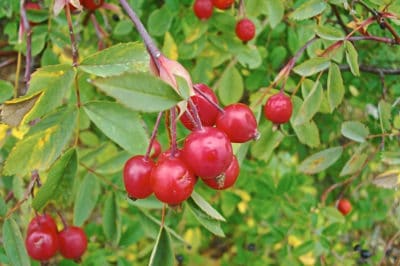What Are Rose Hips?
We grow roses (Rosa spp.) for their flowers. Roses grow their flowers to make hips. Those gorgeous blooms and intoxicating fragrances have one purpose: To attract pollinators that fertilize the flowers and their seeds.
You’ll know a rose is fertilized when its petals start withering and dropping and its base swells to encase its developing seeds.
Do All Roses Produce Hips?
All roses are capable of it, but some are too densely petaled for insects to fertilize. And deadheading once-blooming varieties removes their hips for the year. Repeat bloomers produce hips if you stop deadheading them in August.
Why Should I Harvest Rose Hips?
- For their Vitamin C. Ounce for ounce, wild rose hips have more than eight times the vitamin C of oranges. And you can grow them in every USDA plant hardiness zone from 3 through 11. You can’t say that about oranges.
- For their other nutrients. Ripe rose hips get their red, orange , yellow or purple coloring from carotenoids, including beta-carotene, lycopene, zeaxantin and lutein.
- For their refreshing taste, a blend of crabapples, rose petals and sweet plums.
When Are Rose Hips Ready to Harvest?
The best time to harvest rose hips is right after your first fall frost sweetens them and your roses are less likely to put out cold-sensitive new growth.
Expert gardener’s tips:
- Harvest plump, slightly soft hips free of mushy or brown spots.
- Never harvest any that may have been sprayed with toxic chemicals.
- When foraging for wild hips, avoid roses growing close to busy roads.
How Do I Harvest Rose Hips?
Pull any old petal remnants off a hip and then remove it with clean, sharp pruning shears. Make the cut as close to the hip’s base as you can.
How Do I Process Rose Hips?
To preserve their Vitamin C, always process rose hips with non-aluminum utensils.
Washing large hips, slice off their bases and tops and cut them in half. Scoop out the seeds the tiny hairs inside.
Arrange the hips in single layers on baking sheets or dehydrator trays and oven dry or dehydrate them at 110°F (43.3°C) until brittle. Dry small hips whole, without removing their seeds.
Store your dried hips inside airtight jars in a cool, dry location. Before using, simmer them in water until soft and strain them to remove the remaining seeds.
